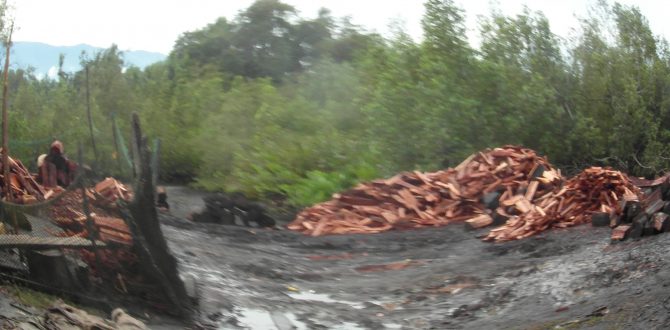They are supposed to contribute in protecting Cameroon from rising sea levels, floods, and global warming, but between 1980 and 2006 the country lost 28% of its mangrove forests to desperate “matanda warriors”, continuously fuelled by increasing harvesting rate within the past few years. Matanda is a local word for mangrove.
The matanda warriors go deep into the creeks along the Tiko shores in the South West Region; cut the trees and haul them by canoe to the beaches for splitting into firewood for sale.
At Kuwait and the Apollos beaches, The Green Vision counted over 10 piles of split mangroves awaiting customers. The same scenario is found at the Avion Beach, where now only very young mangroves are left.
“That is where they sell the split mangrove to people from Tiko and other neighboring villages, who use the firewood to smoke fish and also for construction props,” James Nadong, a resident of Avion Beach, told The Green Vision.
The president of one of the mangroves harvesting groups popularly known as Wood Warriors, David Ndeley, described the harvesting process; “we go far into the marshy area, cut the woods and bring to the beach where our customers, mostly from Tiko and neighboring villages, come and buy for cooking and fish smoking.”
These mangrove harvesters are not unaware of the consequences of their activities.
“We are aware of the negative effects of cutting down these trees but we don’t have a choice. As you can see most of us here have Advanced Level certificates but no jobs…some of us have wives and children to take care of and this is our only source of income. There are also students who depend only on the sale of mangroves to pay fees and buy other basic needs,” Ndeley said.
Another mangrove harvester, who preferred anonymity, said, “we earn at least 2000 FCFA daily from harvesting mangroves and now the government wants us to leave. Where else do they want us to go to? We could harvest other trees but all the trees belong to the government.”
The matanda warriors reportedly received warnings from the Fako Delegation of Forestry and Wildlife in August.
“Since then, we have not seen them here again,” Nadong said.
To intensify the conservation of marine biodiversity as well as reduce the depletion of the country’s mangrove ecosystem, the Minister of Environment, Protection of Nature and Sustainable Development, Hele Pierre, February 6, 2013 launched a five-year project worth some 3 billion FCFA for the conservation and sustainable management of mangroves ranging from the Tiko creeks to Rio del Rey.
According to the Mangrove Conservation consultant, Dr. George B. Chuyong, who doubles as Head of Department for Botany and Plant Physiology at the University of Buea, the project, funded by the Global Environment Facility (GEF) in collaboration with Cameroon Wildlife Conservation Society (CWCS), Cameroon Ecology (CAMECO), and Organisation for Sustainable Development (OPED), is aimed at reducing the over 28 % of Cameroon’s lost mangroves to less than 20% by 2018.
Given that a larger percentage of mangroves are harvested for the smoking of fish, Dr. Chuyong said improved smoking houses will be constructed to replace the open smoking houses.
He explained that the improved smoking houses will reduce the wood consumed to about 70% and the drying duration from three days to about seven hours which will tremendously reduce pressure on the mangroves.
“The project will also boost natural regeneration by restraining the encroachment of fishermen to regenerated areas and stopping the harvesting of mangroves at the edge because they serve as breaks and stop tides from destroying young mangroves,” Chuyong told The Green Vision.
In addition, artificial regeneration will be carried out.
“We are already forming groups and associations in the project area, whose members will be trained on the establishment and management of nurseries and the transplanting of mangroves,” Chuyong said.
The groups, according to him, will also be schooled on the proper harvesting of mangroves.
Meanwhile, the consultant blames the loss of the country’s mangroves on the lack of existing laws for mangrove conservation and the conflicting role of the Ministry of Forestry and Wildlife, Fishery and Livestock and Environment, Protection of Nature and Sustainable Development.
By Bertrand Shancho Ndimuh









An alternative tree specie for matanda which gives smoked fish its customer appraisal value is the only way out to save matanda. Matanda when used to smoke fish gives it a whitish brown colour and good smell which consumers like and go for it. Conservation efforts without an alternative tree specie wich acts in the same line as matanda is like throwing water on a ducks back to matanda havesters
Although smoke houses where given to the indigenous population they still prefer fish smoked with matanda becoz it sells as compared to fish from smoke houses given to them. The most possible solution is for an alternative tree with same capacity as the latter to be introduced to save conservation efforts for mangrove forest